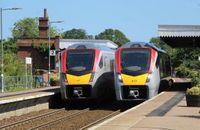Greater Anglia, one of the UK’s most prominent railway operators, officially transitioned to public ownership on October 12, 2025, marking a pivotal moment in the ongoing renationalisation of Britain’s railways. With this move, Greater Anglia becomes the third operator to enter public hands under the government’s Passenger Railway Services (Public Ownership) Act, a development that signals the halfway point in the transfer of franchised rail operators from private to public control.
The company, which runs trains linking Cambridge, Ipswich, Norwich, and Colchester to London, as well as serving Stansted Airport, Peterborough, and a network of smaller lines, has long been at the heart of East Anglia’s transport infrastructure. According to the BBC, Greater Anglia handled a staggering 81.8 million passenger journeys in the 2024-25 period, underscoring its significance in the region’s daily life and economy.
The transfer is more than just a change in ownership; it represents a culmination of years of transformation and success under private management. During its tenure under Transport UK’s stewardship, Greater Anglia experienced a complete overhaul of its services and rolling stock. The company replaced aging British Rail trains with a modern fleet, including Class 720s for London commuter routes, Class 745s for Norwich and Stansted Airport services, and bi-mode Class 755s for regional and intercity journeys. This investment in new trains brought tangible benefits for passengers: more seats, air conditioning, Wi-Fi, plug points, and USB charging, all completed by April 2023.
Punctuality and reliability soared to historic highs. As reported by Economy Class and Beyond, Greater Anglia was the most punctual UK operator for over two and a half years, maintaining a remarkable 94% punctuality rate—well ahead of its 93% target set in 2016 and achieved ahead of schedule in 2021. Between April 2024 and March 2025, 93.9% of trains arrived within three minutes of schedule, a performance that placed Greater Anglia at the forefront of the UK’s rail sector.
This string of successes did not go unnoticed. The operator was named Passenger Operator of the Year at the National Rail Awards three times in four years, and in the week before its transfer, Greater Anglia was also crowned Rail Operator of the Year at the National Transport Awards. The accolades didn’t stop there: 2025 saw the company sweep the board at the Rail Business Awards and Spotlight Rail Awards, cementing its reputation as a leader in the industry.
Timetable improvements have also been a hallmark of Greater Anglia’s recent evolution. The company introduced more frequent services on many routes, launched a new direct Norwich to Stansted Airport connection, and managed to cut average journey times between Norwich and London by six to seven minutes. Accessibility has been enhanced, too, with level boarding available at most stations served by new Stadler-built trains, making life easier for wheelchair users, parents with buggies, cyclists, and travelers with heavy luggage.
Station facilities and integrated transport links have been upgraded, with the operator expanding its successful station adoption scheme and supporting biodiversity through the Wildlife Friendly Stations Accreditation Scheme. These improvements have led to a notable increase in customer satisfaction, a 60% reduction in complaints, and a boost in revenue—a rare feat for a privately run operator, which, according to Economy Class and Beyond, even generated income for the Treasury in 2024.
As Greater Anglia enters public ownership, the company’s leadership is keen to maintain this positive trajectory. Martin Beable, Managing Director of Greater Anglia, expressed both pride in the operator’s achievements and optimism about the future. “We are proud of the transformation we’ve delivered at Greater Anglia in recent years and we’re fully committed to maintaining those high standards as we pass into public ownership. We’re keen to keep on delivering service improvements for customers and communities,” he said. He also thanked the Greater Anglia team and Transport UK for their “ambitious bid” and vision, which enabled the complete replacement of the fleet and a positive step change in services.
Transport Secretary Heidi Alexander echoed this sentiment, highlighting the government’s commitment to reforming the rail system. “From this Sunday, passengers commuting into Norwich or heading for a day out in Cambridge will be travelling on services that are owned by the public and run with their interests front of mind. We’re reforming a fragmented system and laying the foundations for a more reliable, efficient and accountable railway – one that puts passengers first and delivers the high standards they rightly expect,” she said, as quoted by BBC.
Looking ahead, Greater Anglia is set to play a vital role in regional growth and development. With government support, the operator will open two new stations—Beaulieu Park in north Chelmsford this month and Cambridge South early next year. These stations are poised to support the delivery of thousands of new homes, schools, and employment opportunities, further embedding the railway’s role in the community’s future.
The transfer of Greater Anglia to public ownership is part of a broader trend. Other operators already under government control include c2c, Northern, TransPennine Express, Southeastern, LNER, and South Western Railway. Scotrail and Caledonian Sleeper are managed by the Scottish Government, while Transport for Wales (Trains) is overseen by the Welsh Government. The Department for Transport has also announced that West Midlands Trains will transfer back to state ownership on February 1, 2026, followed by Govia Thameslink Railway (GTR) on May 31, with Chiltern Railways and Great Western Railway expected to follow. Meanwhile, Avanti West Coast, CrossCountry, and East Midlands Railway remain in private hands for now, and open access and freight operators are unaffected by the changes.
To ensure a smooth transition and continued improvement, integrated leadership teams are being established across publicly owned train operators and Network Rail routes. The goal is to increase collaboration and accountability, delivering tangible benefits for both passengers and freight users. Martin Beable summed up the ambition succinctly: “This transition also brings us one step closer to Great British Railways – a simpler, more unified network that puts passengers at its heart. Together, we can create a railway that drives growth, sustainability and pride for the communities we serve and right across the UK.”
As the government pushes forward with its Great British Railways vision, passengers, communities, and industry insiders alike will be watching closely to see whether the new era of public ownership can build on the strong legacy left by Transport UK and deliver a railway that truly meets the needs of modern Britain.






